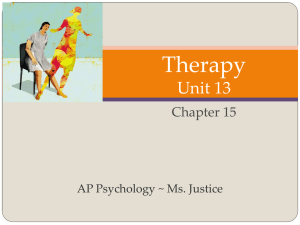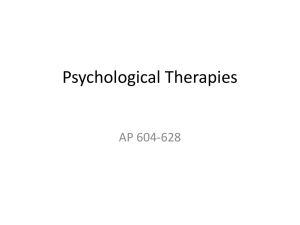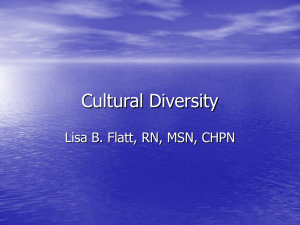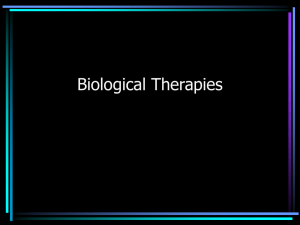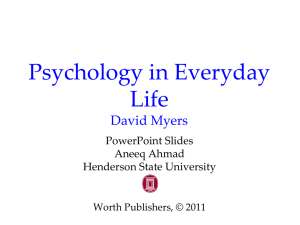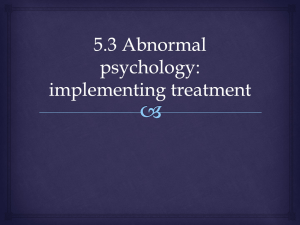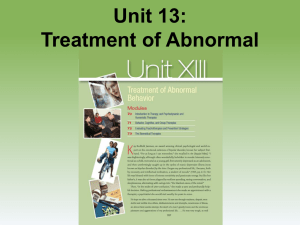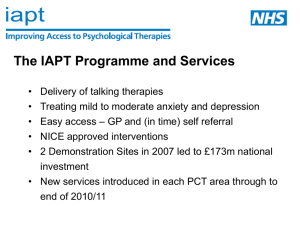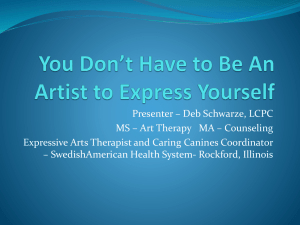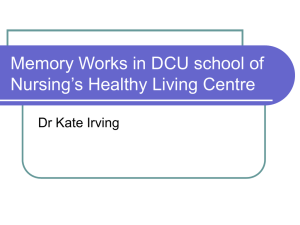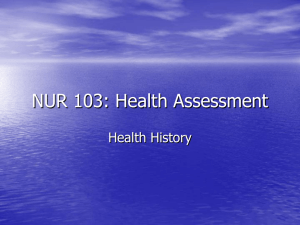Behavior Therapy
advertisement
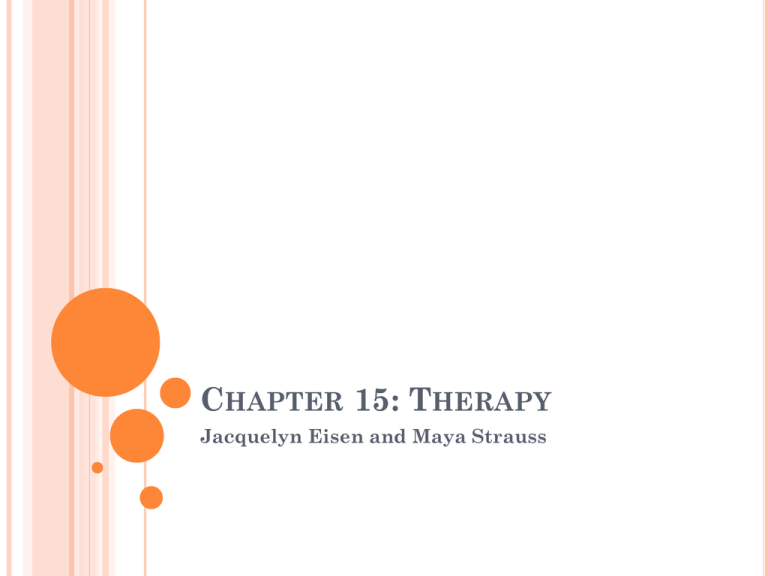
CHAPTER 15: THERAPY Jacquelyn Eisen and Maya Strauss HISTORY OF TREATMENT Bleeding Drilling Holes in Head Administering Electric Shocks A trained therapist uses psychological techniques to assist someone seeking to overcome difficulties achieve personal growth. DORTHEA DIX “I…call your attention to the state of the insane persons confined within the common weath, in cages” MENTAL HEALTH HOSPITALS EMPTYING Introduction of therapeutic drugs Community based treatment programs. THERAPY Pyschotherapy Integration: Attempts to combine a selection of assorted techniques into a single, coherent system THERAPY Eclectic Approach: an approach to psychotherapy that, depending on the client’s problems, uses techniques from various forms of therapy THERAPY Psychotherapy: treatment involving psychological techniques; consists of interactions between a trained therapist and someone seeking to overcome psychological difficulties or achieve personal growth. 4 Major Theories: Psychoanalytic Humanistic Behavioral Cognitive THERAPY- PSYCHOANALYSIS Psychoanalysis Freud believed the patient’s free associations, resistances, dreams, and transferences – and the therapist’s interpretations of them – released previously repressed feelings, allowing the patient to gain self-insight use has rapidly decreased in recent years Neo-Freudians: psychologists today who use psychoanalysis FREUD & PSYCHOANALYSIS Hypnosis is unreliable Goal: unearth the past in hope of unmasking the present THERAPY- PSYCHOANALYSIS Free Association: say whatever comes to mind Interpretation: the analyst’s noting supposed dream meanings, resistances, and other significant behaviors in order to promote insight Transference: the patient’s transfer to the analyst of emotions linked with other relationships love or hatred for a parent THERAPY - PSYCHOANALYSIS Resistance: blocking from consciousness of anxiety-laden material Latent Content: Underlying but censored, meaning of a dream. THERAPY - PSYCHOANALYSIS Goal of dream analysis: determine the meaning of dreams Criticism: interpretations cannot be proven or disproven Rebuttal: It helps the patients. Costly: 3 times a week at $100 an hour More costly than psychodynamic because there is more sessions THERAPY Psychodynamic theory: Drives from psychoanalysis, views individuals as responding to unconscious forces and childhood experiences. Seeks to enhance self insight. THERAPY Interpersonal Psychotherapy: A brief variation of psychodynamic therapy, has been effective in healing depression. Helps people gain insight into roots of their difficulties. HUMANISTIC THERAPY Aim is to boost self-fulfillment. Similarity between this and psychodynamic: Attempt to reduce inner conflicts by providing new insight HUMANISTIC VS. PSYCHOANALYSIS THERAPISTS Present and future vs. past Conscious vs. unconscious Responsibility vs. hidden determinants Promote growth vs. cure illness HUMANISTIC THERAPY Insight Therapies: Aim to improve psychological functioning by increasing client’s awareness of underlying motives and defenses. HUMANISTIC THERAPY Client-Centered Therapy humanistic therapy developed by Carl Rogers therapist uses techniques such as active listening within a genuine, accepting, empathic environment to facilitate clients’ growth GAE (genuine, accepting, empathy) NON-DIRECTIVE THERAPY VS. PSYCHOTHERAPY Feedback (insight) CARL ROGERS “Thank god, somebody heard me. Somebody knows what it is like to be me.” Goal: accept and understand the client 3 Hints that Rogers gives for us to actively listen more: Paraphrase Invite clarification Reflect feeling HUMANISTIC THERAPY Active Listening: empathic listening in which the listener echoes, restates, and clarifies ERSC (England rugby supporters club) Unconditional Positive Regard: Caring, accepting, non-judgmental attitude, Rogers believed to be conducive to developing self-awareness and self acceptance. BEHAVIOR THERAPY Behavior Therapy: therapy that applies learning principles to the elimination of unwanted behaviors Counter conditioning: uses classical conditioning to evoke new responses to stimuli that trigger unwanted behaviors MARY COVER JONES Systematic Desensitization Peter is afraid of rabbits Caged rabbit when he eats closer each day 2 months later, Peter has a rabbit in his lap while eating Didn’t get credit because she’s a woman BEHAVIOR THERAPY: MALADAPTIVE BEHAVIORS Treating phobias and sexual disorders Learned behaviors replaced by constructive behaviors MOWRER Conditioning: Don’t wet the bed Wet the bed Alarm ¾ of the time it was effective Boosts self image BEHAVIOR THERAPY Exposure Therapy: treat anxieties by exposing people (in imagination or reality) to the things they fear and avoid EX: BEHAVIOR THERAPY Systematic Desensitization type of counter conditioning associates a pleasant, relaxed state with gradually increasing anxiety-triggering stimuli commonly used to treat phobias BEHAVIOR THERAPY Progressive relaxation: relax one muscle group after another until completely relaxed BEHAVIOR THERAPY Virtual Reality Exposure Therapy: Progressively exposes people to simulations of their greatest fear (ex: spiders, flying, speaking) It feels like it’s real so it gives a greater relief from fears. BEHAVIOR THERAPY Aversive Conditioning type of counter-conditioning that associates an unpleasant state with an unwanted behavior Nausea pill in alcohol don’t want alcohol anymore Short term solution MENUSTIK (1983) Drinking Aversion & Cognitive Influence At a bar versus the therapist’s office, they know that they can drink without the fear of nausea BEHAVIOR THERAPY Behavior Modification: Reinforcing desired behaviors and withholding reinforcement for undesired behaviors or punishing them REAL LIFE POSITIVE REINFORCEMENT In school, children behave more rationally Intellectual disability kids can care for themselves Kids with autism can learn to interact LOVAAS (1987) Uncommunicative autistic toddlers need intense treatment Many improve BEHAVIOR THERAPY Token Economy an operant conditioning procedure that rewards desired behavior patient exchanges a token of some sort, earned for exhibiting the desired behavior, for various privileges or treats BEHAVIOR THERAPY Token Economy Criticisms: How durable is the behavior? Is it right to control others behaviors? We should: Shift patients towards other rewards COGNITIVE THERAPY Cognitive Therapy teaches people new, more adaptive ways of thinking and acting based on the assumption that thoughts intervene between events and our emotional reactions Teach more constructive ways of thinking AARON BECK Originally trained in Freudian techniques Now is a cognitive therapist Reverse clients creating bad beliefs about themselves MEICHENBAUM Stress inoculation training Teaches people to reconstruct their thinking in stressful situations Advice to someone that studies hard, but is extremely negative prior to testing: Relax SELIGMAN (2002) After being trained to dispute their negative thoughts, depression-prone children and college students exhibit a halved rate of future depression COGNITIVE THERAPY Cognitive Behavior Therapy: popular integrated therapy that combines cognitive and behavior therapies Changing self defeating thinking and behavior SCHWARTZ (1996) OCD people re-labled their compulsive thoughts Have an urge versus actually doing it COGNITIVE THERAPY The Cognitive Revolution COGNITIVE THERAPY A cognitive perspective on psychological disorders COGNITIVE THERAPY Cognitive therapy for depression COGNITIVE THERAPY Cognitive-Behavioral Therapy: a popular integrated therapy that combines cognitive therapy (changing self-defeating thinking) with behavior therapy (changing behavior) GROUP AND FAMILY THERAPIES Benefits Price (more than one person) Find others with similar problems Get feedback as they try things out GROUP AND FAMILY THERAPIES Family Therapy: treats the family as a system, views an individual’s unwanted behaviors as influenced by or directed at other family members GROUP AND FAMILY THERAPIES Goals: Heal relationships Mobilize family resources Success: Helps families cope with disorders GROUP AND FAMILY THERAPIES Support Groups Anorexia AIDS Illness Hearing loss No Support Groups Ulcers Migraine Hypertension Vision loss GROUP AND FAMILY THERAPIES AA 114,000 groups 2 million+ members Effectiveness: Project Match Moos + Moos GROUP AND FAMILY THERAPIES Characteristics of a 12 Step Program Members admit powerlessness Seek help Take the message to others GROUP AND FAMILY THERAPIES Support groups reflect: Longing for community Connectedness REMEMBER: INCREASE 1991 TO 2004 25% increase Justified placing hope in psychotherapy CLIENT TESTIMONIALS TELL US… We can affirm its effectiveness PSYCHOTHERAPY CRTICISMS Often enter therapy in crisis People may need to believe it’s worth it. Speak kindly of therapist. JOAN MCCORD: 500 MA BOYS Years later the kids say that without therapy many of them would be in jail. Clinician’s perspective could often be inflated when judging whether the treatment was effective because they treasure compliments. EVALUATING PYSCHOTHERAPIES Placebo effect: power of belief in a treatment. EVALUATING PSYCHOTHERAPIES Regression toward the mean tendency for extremes of unusual scores to fall back (regress) toward their average EVALUATING PSYCHOTHERAPIES Meta-analysis procedure for statistically combining the results of many different research studies EVALUATING PSYCHOTHERAPY Examples of Regression to the Mean: Students who higher than usual on a test will be closer to the average the second time ESP loses power second time Bad half and a normal second half (game) Why someone would attribute a therapist for their success when it isn’t: Start out better then eventually go back to normal. PHYSICIANS, BLEEDING, & TYPHOID FEVER The control group improved on bed rest HANS EYSENCK Effectiveness of Psychotherapy: 2/3 receiving psychotherapy for non-psychotic disorders improved remarkably Problems: His sample was small (only 24 studies of psychotherapy outcomes in 1952) EVALUATING PSYCHOTHERAPIES Best way to study outcome research: Randomized clinical trials Randomly assign people on waiting list and later evaluate everyone. SMITH (1980) Clients end up 80% better than those not treated 5 Subsequent studies: Those not undergoing therapy often improve, but those undergoing therapy are more likely to improve. PSYCHOTHERAPY IS COST EFFECTIVE Search for other treatment drops Boosts well being Reduces long term cost BEHAVIORAL PROBLEMS THAT BENEFITTED FROM BEHAVIORAL CONDITIONING THERAPIES Bed-wetting Phobias Marital Problems Compulsions Sexual Disorders COGNITIVE THERAPY EFFECTIVENESS Coping with Depression’ Lowering suicide risk I DON’T RECOMMEND.., Energy Therapies Recovered-Memory Therapies Facilitated Communication Crisis Debriefing Rebirthing Therapies DEFINING: Evidence-Based Practice: clinical decision making that integrates best available research with clinical expertise and patient characteristics and preferences. EVALUATING PSYCHOTHERAPIES EVALUATING PSYCHOTHERAPIES To whom do people turn for help for psychological difficulties? EVALUATING PSYCHOTHERAPIES Number of persons Average untreated person Poor outcome 80% of untreated people have poorer outcomes than average treated person Average psychotherapy client Good outcome EVALUATING PSYCHOTHERAPIES EVALUATING ALTERNATIVE THERAPIES EMDR (Eye movement desensitization and reprocessing): therapy illustrating the differences between scientific and pseudo scientific therapy techniques Francine Shapiro – walking in a park and observing anxious thoughts vanish as her eyes spontaneously darted about. FRANCINE SHAPIRO & EMDR Tested 22 people by moving finger in front of eyes: reductions in stress after one session Amount Trained: Countries that use it: 70,000 70 Credibility: Chambless Bisson & Andrews EMDR SKEPTICS Eye movement is not therapeutic EVALUATING ALTERNATIVE THERAPIES Seasonal Affective Disorder: Winter time depression Oversleeping Gaining weight Light Therapy Works: 90 minutes of light vs. none – those with light were more improved 30 minutes of exposure is relief Morning light works best COMMONALITIES AMONG PSYCHOTHERAPIES Hope for demoralized people Participant’s beliefs may function as a placebo New perspectives Empathetic, trusting, caring relationship New attitude open to making changes THERAPISTS effective therapists are empathic people who seek to understand another’s experience; who communicate their care and concern to the client; and who earn the client’s trust and respect through respectful listening, reassurance, and advice. COGNITIVE, PSYCHODYNAMIC, INTERPERSONAL The empathic therapists of both persuasions would help clients evaluate themselves link one aspect of their life with another gain insight into their interactions with others. THERAPISTS Therapeutic Alliance: emotional bond between therapists and their client THERAPISTS Paraprofessional Attribute: New perspective offered by a caring person People that need/seek therapy: Feel supported by close relationships Enjoy friendship Therapists attempt to enhance: Sensitivity, openness, personal responsibility, and sense of purpose THERAPIES AND MINORITIES Immigrant problems: different kind of culture Problems from a minority viewpoint: reluctant to use mental health services Asian American viewed therapists from a collectivist background as more empathetic and had a stronger alliance. If religious, find a therapist with a similar religion as you. Albert Ellis Rational-emotional therapy Nothing is supreme (vs. Bergin who thought God is supreme and everything else is virtue) Most important: psychotherapists personal beliefs influence their practice THERAPISTS AND THEIR TRAINING Clinical psychologists Most are psychologists with a Ph.D. and expertise in research, assessment, and therapy, supplemented by a supervised internship About half work in agencies and institutions, half in private practice THERAPISTS AND THEIR TRAINING Clinical or Psychiatric Social Worker A two-year Master of Social Work graduate program plus postgraduate supervision prepares some social workers to offer psychotherapy, mostly to people with everyday personal and family problems About half have earned the National Association of Social Workers’ designation of clinical social worker THERAPISTS AND THEIR TRAINING Counselors Marriage and family counselors specialize in problems arising from family relations Pastoral counselors provide counseling to countless people Abuse counselors work with substance abusers and with spouse and child abusers and their victims THERAPISTS AND THEIR TRAINING Psychiatrists Physicians who specialize in the treatment of psychological disorders Not all psychiatrists have had extensive training in psychotherapy, but as M.D.s they can prescribe medications. Thus, they tend to see those with the most serious problems Many have a private practice BIOMEDICAL THERAPIES Biomedical therapy: prescribed medications or medical procedures that act directly on the patient’s nervous system. *only psychiatrists can offer COMPARISONS Psychotherapy is to psychological disorders as biomedical therapy is to serious disorders. BIOMEDICAL THERAPIES Psychopharmacology: study of the effects of drugs on mind and behavior Lithium: chemical that provides an effective drug therapy for the mood swings of bipolar (manicdepressive) disorders (salt) BIOMEDICAL THERAPIES The emptying of U.S. mental hospitals BIOMEDICAL THERAPIES Enthusiasm diminishes after any new treatment… Normal recovery among untreated patients Recovery due to placebo BIOMEDICAL THERAPIES Double-Blind Procedure is used to establish the legitimacy of the drug. (No bias at all) BIOMEDICAL THERAPIES Psychoses: disorders in which hallucinations or delusions indicate some loss of contact with reality Drugs that calmed people from this were found accidentally. BIOMEDICAL THERAPIES DRUG THERAPIES Antipsychotic drugs: drugs used to treat schizophrenia and other forms of severe thought disorder. Chlorpromazine (Thorazine) – dampens responsiveness to irrelevant stimuli Mimics dopamine – occupies receptor sites and blocks activity Reinforces that too much dopamine schizophrenia BIOMEDICAL THERAPIES DRUG THERAPIES Tardive Dyskinesia: involuntary movements of the facial muscles, tongue, and limbs; a possible neurotoxic side effect of long-term use of antipsychotic drugs that target certain dopamine receptors. Dopamine and serotonin receptors for negative symptoms DRUG THERAPIES Antipsychotic drug side effects: Increase risk of obesity and diabetes Positive Gain: Able to return to work and have near normal lives DRUG THERAPIES Anti-anxiety Drugs: drugs used to control anxiety and agitation. DRUG THERAPIES Anti-depressant Drugs: drugs used to treat depression; also increasingly prescribed for anxiety. Different types work by altering the availability of various neurotransmitters. DRUG THERAPIES Anti-anxiety: Depress CNS activity Xanax Psychological dependence, physiological dependence, withdrawal, insomnia, anxiety DRUG THERAPIES Anti-depressants are standard drug treatment for anxiety disorders. Works on OCD. DRUG THERAPIES Neurotransmitters serotonin and nonepinephrine by upping availability Prozac partially blocks reuptake of serotonin. DRUG THERAPIES SSRI (Selective serotonin reuptake inhibitor): Prozac, Zoloft, Paxil Most effective way to administer is by patch. 1987 2001, 70% 89% with SSRIs BARBER (2008) 11% women taking anti-depressants 5% men taking anti-depressants DRUG THERAPIES 4 weeks to work Diminishes sexual desire Delay because up serotonin = neurogenesis (new brain cells), reducing stress including loss of neurons DRUG THERAPIES Without drugs: Cognitive therapy Exercise To hit it from above and below use both: Cognitive Therapy Anti-Depressants DRUG THERAPIES Only the most severely depressed patients should take these meds. DRUG THERAPIES There is no link between adolescent SSRI prescriptions and suicide. Less suicides when treated with meds (long run) BIOMEDICAL THERAPIES Electroconvulsive Therapy (ECT): therapy for severely depressed patients in which a brief electric current is sent through the brain of an anesthetized patient Introduced 1938 Originally 100 volts BIOMEDICAL THERAPIES: ECT Under anesthetic for 30 to 60 seconds of electric current. Patients don’t remember it. Works for 4 out of 5 people Doesn’t cause brain damage. BIOMEDICAL THERAPIES: ECT It works because it calms the nerves that cause depression. BIOMEDICAL THERAPIES Repetitive Transcranial Magnetic Stimulation (rTMS): the application of repeated pulses of magnetic energy to the brain; used to stimulate or suppress brain activity BIOMEDICAL THERAPIES rTMS vs ECT: no seizures or memory loss KLEIN (1999) 67 Israelis with major depression: 50% stimulated patients improved 25% placebo patients improved KLEIN (1999) Worked because the stimulation energized depressed patient’s relatively inactive left frontal lobe. MAYBERG 8 out of 12 people implanted with electrodes and pacemaker stimulator experienced relief BIOMEDICAL THERAPIES Psychosurgery: surgery that removes or destroys brain tissue in an effort to change behavior Not used often because its irreversible BIOMEDICAL THERAPIES Lobotomy: now-rare psychosurgical procedure once used to calm uncontrollably emotional or violent patients BIOMEDICAL THERAPIES Rosemary Kennedy had lobotomy done Moniz won the Nobel prize Abandoned in 1950: calming drugs available BIOMEDICAL THERAPIES Benefits: short and cheap Bad Characteristics: produced lethargic, immature, uncreative person THERAPEUTIC LIFESTYLE CHANGES Brains/Bodies designed for physical activity and social engagement Mind and Body AMISH & DEPRESSION BEING OBSOLETE 1. 2. 3. 4. Strong Community Ties Sunlight Exposure Tons of Sleep Strenuous Physical Activity ILARDI TEAM & REDUCING DEPRESSION Aerobic Exercise Adequate sleep Light exposure Social Connection Nutritional Supplement ALBEE (1986) Increase the risk of doing more than necessary “IT IS BETTER TO PREVENT THAN TO CURE” Help those who haven’t had a chance Get a vaccine instead of a cure
